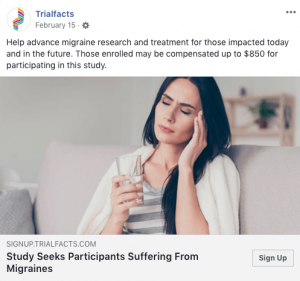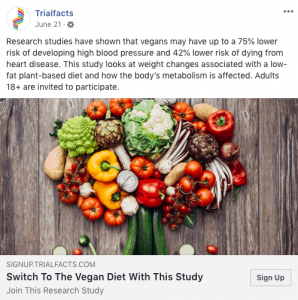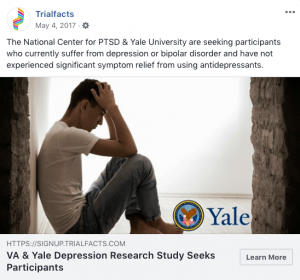 Consumers are exposed to over 10,000 brand messages a day. Whether you’re online or offline, you’re likely to be exposed to some sort of advertisement, mostly through eye-catching images and slogans.
Consumers are exposed to over 10,000 brand messages a day. Whether you’re online or offline, you’re likely to be exposed to some sort of advertisement, mostly through eye-catching images and slogans.
To top it off, being bombarded constantly with advertising has made us less attentive than goldfish. Which means recruiting patients to participate in studies is simultaneously easier and harder than ever. Easier because of the ubiquity of online advertising and harder for the same reason.
This is why every element you use for recruitment, be it an image or a headline, is extremely important. In this article, we’ll cover how you can create effective social media posts for clinical trial recruitment that is relevant to your study, follows ethical guidelines, and most importantly grabs your potential participants’ attention!
Stay Relevant
Because we’re constantly bombarded by information and ads, we’ve become very good at tuning out irrelevant information. Our brain only processes the most important information presented to us.
And while certain companies rely on shocking their viewers to bait them into clicking on ads, it’s not a good approach for clinical trial recruitment. Not only is it incompatible with the Principles of Good Clinical Practice (GCP), but it’s also unlikely to be approved by an IRB or ethics committee.
It also wouldn’t guarantee high-quality participants. In fact, if you’re relying on shock value to attract potential participants, you’ll likely end up with no-shows. Any participant attracted by shock value is less likely to be intrinsically motivated to participate in your study. Instead, they are more likely to be distracted by the next thing that comes along.
To stay in line with ethical guidelines when creating recruitment material and to make sure you’re recruiting high-quality participants, focus on being relevant instead of shocking. Next, we’ll take you through how to choose the right images to attract your target group.
Choose Different Images for Different Demographics
Obviously, whether your ad is relevant to your audience or not has a lot to do with the targeting options you’ve chosen in social media for your campaign. But we can identify images as playing the biggest part in grabbing someone’s attention. Your images and headline should also work together so they are relevant to your participant’s specific situation.
For example, if you’re targeting women aged 18 to 25 who are suffering from migraines, then you’ll want to include an image of a young woman who appears to be suffering from a migraine. Add a relevant headline (see the example below), and your ad will be very pertinent to the demographics you’re targeting.
If you’re focusing on both males and females over the age of 70, you will want to create two different ad campaigns with images to match your demographic– one targeting males over 70, and the other targeting females over 70.
What’s In It For Me? (WIIFM)
The most important part of creating an effective ethics-approved ad is balance. If your ad has very little information about the study and only lists the benefits, it’s likely imbalanced and so unlikely to be approved by an ethics committee.
It’s best to offer ample information on the research in addition to listing any potential benefits. With online advertising, it’s easier to create this kind of balanced material, which is why it’s perfect for recruitment. Take for example a web page created specifically for your study. These are called landing pages and they allow you to present quite a lot of information to your audience—in fact, you can be as detailed as you like. To contrast let’s compare that to a more traditional form of advertising like a radio ad for example. Radio ads only allow a very limited amount of time which then makes it difficult to ensure the ad/information is balanced.
Of course, in order for your promotion to be effective, your potential participants should be made aware of what they will gain from taking part in your study—provide them with an incentive. It’s certainly important to gear your ads to the patient but the more balanced the information the better.
We’ve listed some examples of the benefits you could include in your post below.
Learning
To lead with learning as a benefit will help to create an effective social media post for clinical trial recruitment and is certainly a clever move as it’s one of the most valuable incentives for patients. It’s also a very effective way to communicate the impact and advantages of your research.
There are two types of learning benefits–individual and societal.
Individual Learning
The right kind of participants are intrinsically motivated by what they might learn from your research. They want to understand how it can help them learn about themselves and their condition.
Why did you sign up for the trial?
“I figured why not. I look at it as a way to help with the research and get a better grasp of my health”.
– Participant for a weight loss trial recruited by Trialfacts, 2018
If your studies need healthy participants, for fitness, exercise or health science, for example, potential volunteers might put their hand up because of the interesting tests that may be conducted which may allow them to learn more about their bodies.
For these reasons, it’s a good idea to include information on knowledge they might gain and how it will affect them.
Impact on Society
High-quality participants want to contribute to medical research, and they want to know more about it. Contributing to the development of medical science, possibly helping their children’s generation, or helping patients suffering from the same conditions they are is the incentive.
So be sure your recruitment material lists the ways your participants can help advance medical research, and the impact the results could have on society. How will society benefit from your study? What kind of changes are you hoping to see and how will they affect patients in the future? This will certainly boost enrolment numbers.
Why did you sign up for the trial?
“Anything that will help further our overall knowledge of PTSD and achieve a higher quality of care for vets is a good thing.”
– Participant for PTSD treatment trial, recruited by Trialfacts, 2018
Compensation or Perks
If participants will receive compensation for taking part be sure to mention it if you don’t already. At the same time, it’s important that these perks are not the primary focus of your ad. Take a look at the example below and think about including a similar balanced message in your posts as well.
Potential Improvement
If your patients can gain any potential improvement from your study, be it exercise, or a boosted immune system, try using this as your headline. Again, you can see an example of this below.
But remember: if your ad has very little information about the study and only lists the benefits, then it’s likely imbalanced and may not be approved by an ethics committee.
Be Credible
Some researchers assume that the majority of the population would be happy to participate in studies—in fact, it’s quite the opposite. People generally have a distrust of studies; combined with the label ‘human guinea pig’, we have ourselves quite a challenge. But there are ways to overcome that perception–read on.
Display Your Logo
To create an effective social media post for clinical trial recruitment make sure your logo is displayed on your post. All logos add some credibility, but university logos more than most. Many people trust universities or research institutes over a faceless organization. A professional logo with the full research institute name also makes you relatable to your audience and adds credibility to your ads. With this, potential participants are more likely to trust you and sign up to take part.
Make It Personal
We’ve covered the importance of establishing and developing a relationship with your participants in our enrollment guides, and your recruitment material is the first step to building that relationship.
One way you can do this is by providing information about you on your study’s website or landing page. Telling your participants a bit about yourself helps build a personal connection, and elevates your credibility. Provide your name, your position, links to any relevant professional profile pages (e.g. university page, LinkedIn profile, etc.), and most importantly, add a photo of yourself!
Make It Human
We’ve already been through using images of people who your participants can relate to for your recruitment ads, but one other small consideration which can make quite an impact is using images with people in them. Humans are social creatures, and we’re more likely to trust in someone if we can identify with them. Use high-quality images—stay away from generic ones that feel false or cheesy. Remember, you want to be relatable, not shocking.
What Next?
When you’re creating effective social media posts for your clinical trial recruitment, it’s important to be relevant to your participants’ interests and demographics, and be credible by portraying your study in a professional but personal manner. In order to recruit successfully, you need to gain your participant’s trust. That’s why randomly selecting a generic image and adding a shocking headline simply doesn’t work. Your recruitment material should reflect your organization and research and should instill trust in your participants. Good recruitment material also acts as a filter, bringing in high-quality participants and eliminating anyone who might sign up for the wrong reasons and end up as no-shows.







